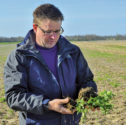Focus on Conservation Fuels Low-Cost Production, Long-Term No-Till Future
Contour farming, no-till, cover crops and a sustainable farming cycle are allowing Wisconsin No-TIller Jack Herricks and his family to remain profitable and viable for future generations to come.
Read More







.png?height=125&t=1731942302&width=150)




